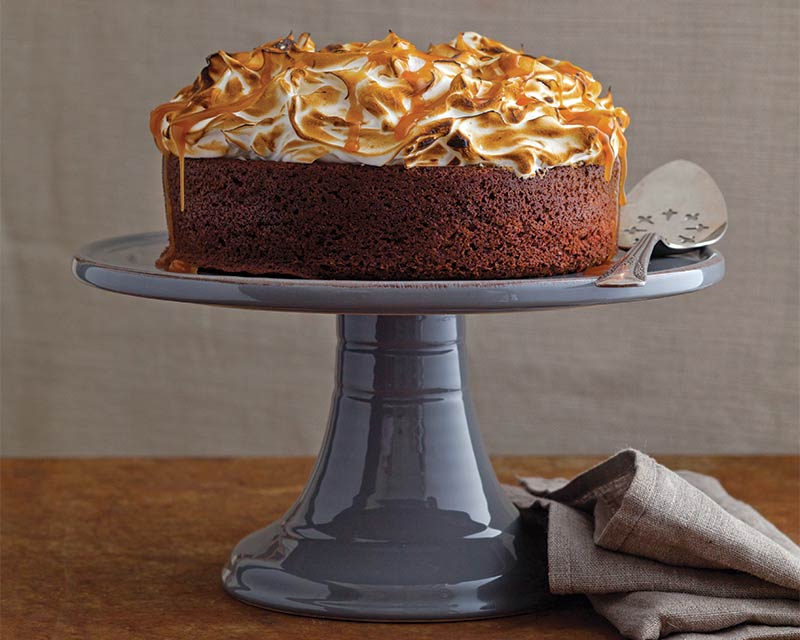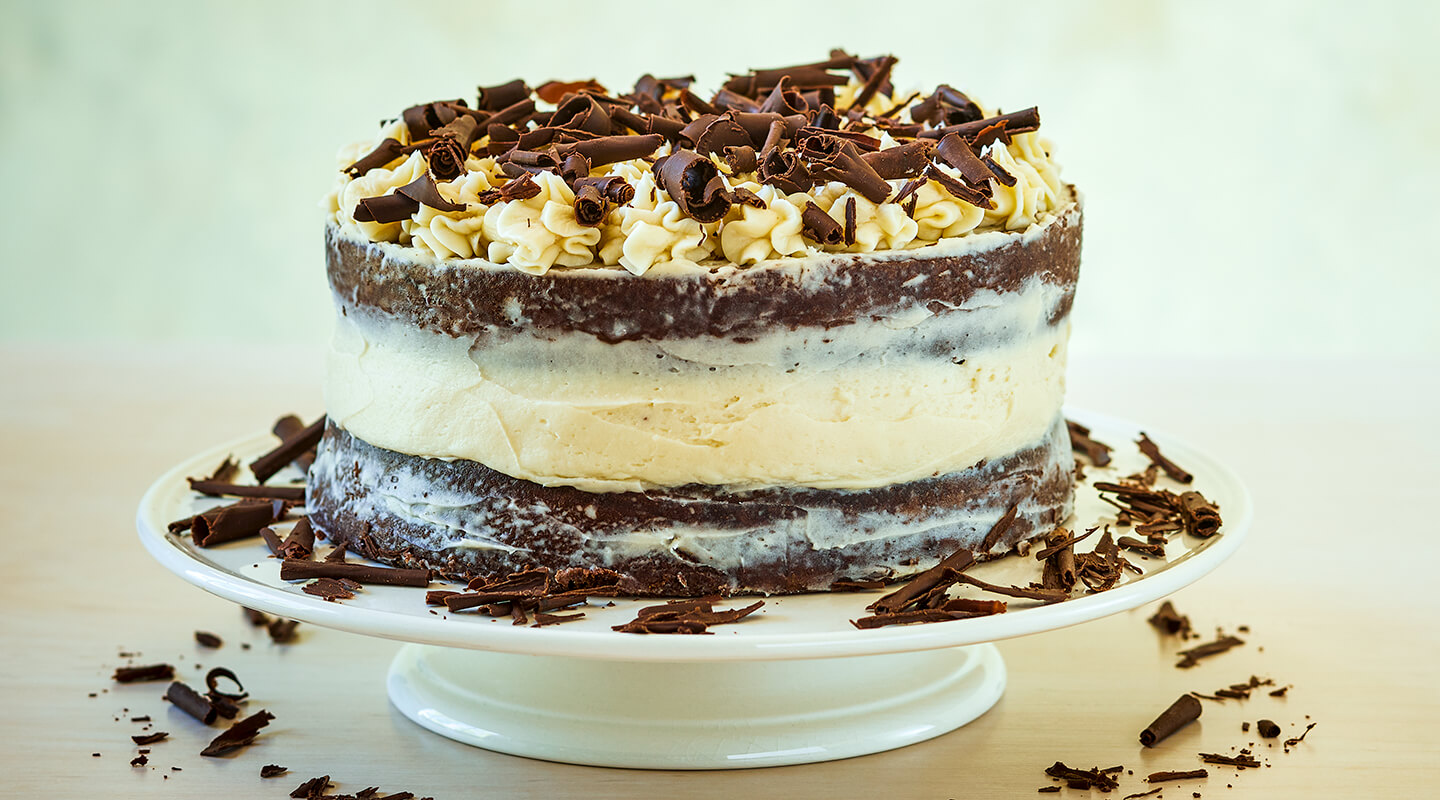Beer can be a baker’s secret weapon. It adds complex depth to sweets and amplifies the toasty flavor of savory breads and crackers. Its natural leavening abilities give extra lift to quick breads and layer cakes. It adds moisture and can cut down on proof time in yeast breads. And because the alcohol inhibits gluten formation, baking with beer results in a tender, delicate crumb. Luckily, today’s obsession with craft beer is a boon for bakers, as you’ll find an impressive range of options available at nearly every grocery store and corner market across the country. The following recipes focus on five major styles of beer—IPA, Stout, Saison, Kölsch, and Oktoberfest—but don’t be afraid to experiment with a bottle of your go-to brew.
STOUT: Rich and dark with soft carbonation, stouts can range from sweet to dry with big roasty-toasty notes. Expect notes of chocolate, sweet caramel, or bitter coffee—all of which work beautifully with the cocoa powder and malted milk in our layer cake.
We like: Guinness Draught, The Duck Rabbit Craft Brewery Milk Stout, Modern Times Black House Stout
What to make: Chocolate, stout, and malt are a stellar match made in heaven in this strikingly tall 2-layer Cocoa-Stout Cake with Malted Buttercream. If needed, you can use 9-inch pans—just trim a few minutes from the bake time.
What to make: You can’t have Irish soda bread without Guinness. Along with incorporating the signature dry stout, this Apple Guinness Cheddar Soda Bread pairs the earthy tang of sharp Cheddar cheese with the tart crunch of Granny Smith apples.
SAISON: Delicate, refreshing, and bright with complex citrus, spice, wheat flavors. Pairs well with the pear, honey, and cinnamon in our loaf cake.
What to make: In this impressive Saison Pear-Date Cake, spices, dates, nuts, and pears scream make for an irresistible aromatic loaf. We used highly prized Warren pears, but you can try firm and ripe Seckel or Comice pears as well.
INDIA PALE ALE: Also labeled IPA, these beers have a super-hoppy aroma with addictive bitter and malt qualities. IPAs add a pleasantly strong bitter bite to our Pub Cheese Spread, and hold up to the whole wheat flour in our cracker recipe.
What to make: Who knew crackers were so simple to make? Plus, you probably have all five of the pantry ingredients you need to make these Sesame-IPA Saltines on hand already. For robust bitter flavor, choose an IPA-style of beer over the milder pale ale in both the cracker and cheese spread.
KÖLSCH: Light, dry, and crisp with malty flavors and delicate hops; a milder all-day drinking beer ideal for bread baking. It complements the yeast and cheese perfectly in our fantails.
What to make: The nutty flavor of Gouda pairs well with the pilsner and yeast in these Parmesan-Gouda Fantails, but you can easily swap Muenster, Edam, or Monterey Jack cheeses in place of the Gouda, if desired.
 What to make: In this Guinness Stout Cake, the malt and coffee flavors of stout beer pair seamlessly with Bourbon Caramel and toasted Meringue. The addition of bourbon dresses up an already decadent dessert sauce, which speaks for itself: a little creamy, a little salty, and perfectly smooth, with a hint of vanilla and a punch of bourbon.
What to make: In this Guinness Stout Cake, the malt and coffee flavors of stout beer pair seamlessly with Bourbon Caramel and toasted Meringue. The addition of bourbon dresses up an already decadent dessert sauce, which speaks for itself: a little creamy, a little salty, and perfectly smooth, with a hint of vanilla and a punch of bourbon.
OKTOBERFEST: Also known as “Märzen style,” this beer is of German origin and has a deep amber color. Flavors include sweet, toasty, nutty, and bready with the right balance of crisp bitterness. Malt complements the maple glaze, giving it an interesting edgy twist.
What to make: These Maple and Beer Glazed Doughnuts are quite the sugary delight! For milder beer flavor, brush hot beer doughnuts in melted butter and toss in a brown bag with lots of cinnamon sugar before topping with maple glaze.
The presence of the stout gives the cake a complex finish and the slightly bitter hops from the beer act as a counterpoint to the sugar in the cake. It’s an incredibly moist cake, too, and its rich, dark color comes mostly from the beer.

We like: Guinness Draught, The Duck Rabbit Craft Brewery Milk Stout, Modern Times Black House Stout
INDIA PALE ALE: Also labeled IPA, these beers have a super-hoppy aroma with addictive bitter and malt qualities. IPAs add a pleasantly strong bitter bite to our Pub Cheese Spread, and hold up to the whole wheat flour in our cracker recipe.
KÖLSCH: Light, dry, and crisp with malty flavors and delicate hops; a milder all-day drinking beer ideal for bread baking. It complements the yeast and cheese perfectly in our fantails.
What to make: The nutty flavor of Gouda pairs well with the pilsner and yeast in these Parmesan-Gouda Fantails, but you can easily swap Muenster, Edam, or Monterey Jack cheeses in place of the Gouda, if desired.
What to make: You can’t have Irish soda bread without Guinness. Along with incorporating the signature dry stout, this Apple Guinness Cheddar Soda Bread pairs the earthy tang of sharp Cheddar cheese with the tart crunch of Granny Smith apples.
While beers that are today called pastry stouts have been made for some time, they really didn’t start to be noticed until after 2000. I recall trying beers like Southern Tier’s Choklat and Mikkeller’s Beer Geek Breakfast in the mid-2000s, and finding them very sweet for their description. The trend of making experimental beers accelerated after hazy IPAs started to be made into milkshake IPA variations in the mid- to late-2010s, and sweetness caught on as a desirable beer component after years of consumers chasing bitterness in IPA, sourness in wild beers, and barrel-aged beers of all forms.
Pastry stout is a modern craft beer phenomenon that takes specialty beers to the extreme. Packing massive sweetness and the flavors often found in desserts and pastries into a strong dark stout, the beers are often sought-after commercial creations popular in the modern era of social media. While having a cult following, the relatively young style has few rules and emphasizes brewer creativity in executing the concept. Many breweries make one-off versions and are constantly trying new variations, which makes it difficult to define the beer in the traditional sense. It is best thought of as an ingredient-driven specialty beer with several commonly used attributes.
This is going to be hard, as there are so many choices to make. The grist sounds somewhat similar to an imperial stout in that it chooses from four main groups: Base malts, dark malts and grains, crystals and sugars, and adjuncts. But the proportions are often quite different. The base malts are often pale ale malt or blends of pale malts. Dark malts and grains can include roasted barley, black malt, chocolate malt, and other roasted grains such as chocolate wheat, chocolate rye, and the various dehusked/debittered variants of these dark grains. Lighter color versions of these grains are sometimes used as well as the debittered versions to keep the roastiness down.
These beers typically have thick or chewy body and mouthfeel, often with silky or dextrinous qualities. The high sugar content can give a heavier mouthfeel as well, and can sometimes approach something cloying, although the alcohol tends to offset this impression. The alcohol level is high, which often makes it similar to an imperial stout in strength but the balance will seem very different since the bitterness levels are usually quite restrained to avoid challenging the sweetness for dominance.
Neither the Beer Judge Certification Program (BJCP) nor the Brewers Association (BA) list pastry stout as a named style, preferring to let existing specialty and experimental styles address it. I think this reflects the fact that the beers can vary widely and that they are very ingredient-driven. The most typical place to put pastry stouts in a BJCP competition would be category 30D Specialty Spice Beer, which allows variations of spice, herb, and vegetable (SHV) beers (a base style with a number of SHV ingredients) with sugars, sweeteners, and unfermentable sugars added. The base styles in these beers can be used loosely, such as stating a style family (e.g., “stout”) or giving a general description of the beer. Versions not using spices might be placed in 31B Alternative Sugar Beer, and those versions using fruits along with spices should go in 29C Specialty Fruit Beer (which allows a fruit and spice base beer, along with additional sweeteners).
Heavenly Chocolate Stout Cake With Chocolate Ganache – So Moist And Fluffy!
FAQ
What can I use instead of stout in cake?
What can I use instead of stout in a recipe?
Does stout cake have alcohol?
What is the use of stout?
How do you make a stout cake?
Place a rack in middle of oven; preheat to 350°. Coat three 8″-diameter cake pans with unsalted butter and line with parchment paper rounds; butter parchment. Bring 2 cups stout and 2 cups unsalted butter to a simmer in a medium saucepan. Add 1½ cups Dutch-process cocoa powder and whisk until mixture is smooth.
What do you put in a stout cake?
stout: the liquid in the cake. Adds depth of flavor and subtle maltiness sour cream: adds a touch of mellowness, a bit of extra fat, and milk solids to up the protein a bit. You can also use creme fraiche or Greek yogurt. Note, this cake is made using the dissolved sugar method.
What does a stout cake taste like?
The presence of the stout gives the cake a complex finish and the slightly bitter hops from the beer act as a counterpoint to the sugar in the cake. It’s an incredibly moist cake, too, and its rich, dark color comes mostly from the beer. Thanks to Barrington Brewery & Restaurant in Great Barrington, MA for the inspiration for this recipe.
How do you make a chocolate stout?
Heat the beer and the butter until butter is melted. Add vanilla. (And salt) Add espresso powder. Add the sugars. Whisk until smooth. Whisk the eggs and sour cream together. Stir that into the chocolate stout mixture. Add flour, baking powder, and baking soda. Whisk together until almost completely smooth.
